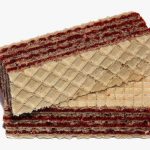In the Germanic language that English partly developed from, there existed a word pronounced something like wab. This word meant honeycomb, the patterned structure formed by bees to store honey, and it gave rise in English to words associated with other kinds of patterned structures: web and weave. These words in turn led to the surnames Webster and Weaver, bestowed long ago on people who wove fabrics for a living. The Germanic wab also developed in other directions. It entered German as wafel, the name of a light cake whose surface has a honeycomb pattern, which was then adopted into French as two words: Norman French took it as waufre and Central French took it as gaufre. (A similar splitting, incidentally, happened to the Germanic word warnon, meaning to warn, which became both guarantee and warranty.) The Norman French member of this pair, waufre, was adopted into English in the fourteenth century as wafer. Its Central French cousin, gaufre, entered English in the middle of the eighteenth century as gofer, yet another name for a thin batter-cake stamped with a honeycomb pattern by hot iron plates. More bizarrely, though, the Central French gaufre also became, in the early nineteenth century, the name given by French settlers in North America to a burrowing rodent that “honeycombs” the earth with its tunnels—the gopher. Finally, in the middle of the eighteenth century, Dutch immigrants to the United States introduced the word wafel, their name for a soft, hot cake served with butter; this word, which of course derived from the same Germanic source as wafer, was then respelt in English as waffle. Surprisingly, this waffle is not related to the verb waffle that means to be wishy-washy or to be undecided; instead, this verb form of waffle developed from the same source as the word wave.
A thin sheet made from moistened flour, formerly used to enclose a powdered medicine that is taken by mouth.
A thin envelope or disk used to enclose a medication or to separate two structures from one another.
An exceedingly thin and delightfully crunchy cookie, delicately sweetened, is often accompanied by a generous serving of ice cream or other delectable treats. Beyond the traditional oblong form, these delectable confections are crafted into an assortment of exquisite and fanciful shapes, adding an extra touch of elegance to their presentation.

